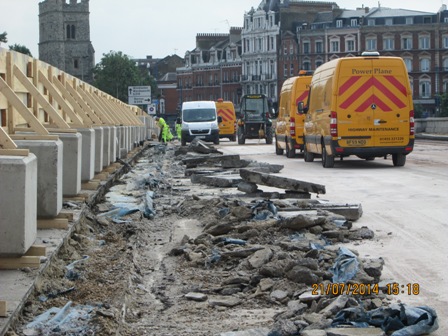Putney Bridge Repairs Update
Two weeks in the council reports that the works are on schedule
Following the old road surface’s removal last week, the focus over the past seven days has been removing the old waterproof membrane, which needs replacing, and preparing the bridge’s underlying concrete deck in advance of the new waterproofing being laid.
 The bridge being "sand blasted" right up to the edge of the eastern walkway
The bridge being "sand blasted" right up to the edge of the eastern walkway
Preparing the bridge deck for the new membrane has involved “sand blasting” away any remnants of the old one and also any solvent residues that were used to fix it in place. Repairs have also begun to fix defects in the deck’s concrete structure.
Kerb stones on both sides of the bridge have also been removed so that the new membrane can be laid across the entire width of the bridge, apart from the eastern footpath. The waterproofing of this section will commence in around three to four weeks time when a wider, western walkway will be opened up for use by pedestrians and cyclists.
The use of sand blasters up to the very eastern edge of the road surface and underneath the kerb stones, and the need to ensure the safety of passers-by, is why large hoardings have had to be erected around the work site and why the footpath is slightly narrower than normal. This will improve considerably when the walkway switches to the wider western side next month.
Work has also continued to refurbish the subway at the northern end of the bridge. The existing wall covering is being removed so that the underlying brickwork can be repaired.
Additional lighting has also been installed on the wooden hoarding to improve visibility and pedestrian safety at night.
And work continues off-site to refurbish the bridge‘s ornate Victorian lamp columns which are being restored by specialist craftsmen.
Transport spokesman Cllr Jonathan Cook said: “The works remain on schedule for October’s reopening. Our focus remains on getting this important repair job completed in the shortest possible time so that things can get back to normal as quickly as possible for the travelling public.”
The bridge is currently closed to all vehicle traffic, including buses so that the £1.5m worth of repairs can be completed during the summer months when traffic is at its quietest.

Removal of the kerbstones ahead of waterproofing
The works also now include a separate project to fix the damage caused earlier this month when a single decker bus crashed into the bridge’s parapet wall. This will involve retrieving six large granite blocks from the riverbed after they were sent plummeting into the Thames as a result of the collision.
Pedestrians can still walk across the bridge as can cyclists as long as they dismount and wheel their bikes across. As an alternative, people can also cross the river by using the rail bridge linking Deodar Road with Putney Bridge tube station.
Cyclists can also use this bridge and to make life easier for them the council has just obtained permission from its owners London Underground Ltd to install cycle rails on the steps. This means cyclists will be able to wheel their bikes up onto the rail bridge instead of having to carry them up the steps. The rails are likely to be installed shortly.
Buses are currently operating a shuttle service from both ends of Putney Bridge. This means that passengers must cross the bridge on foot and catch another bus to continue their journey. Transport for London has confirmed that people only need to pay one fare.
Staff from TfL are positioned on both sides of the bridge to assist passengers. Details of the affected bus routes, along with maps showing where bus stops have been re-postioned, can be found at www.tfl.gov.uk/putney-bridge-closure.
Motorists will need to find alternative routes and are being urged to allow plenty of extra time for their journeys. Up-to-the-minute travel alerts will be available through the @tfltrafficnews twitter feed and on TfL’s website at www.tfl.gov.uk/trafficnews.
August 5, 2014
Related links
|
